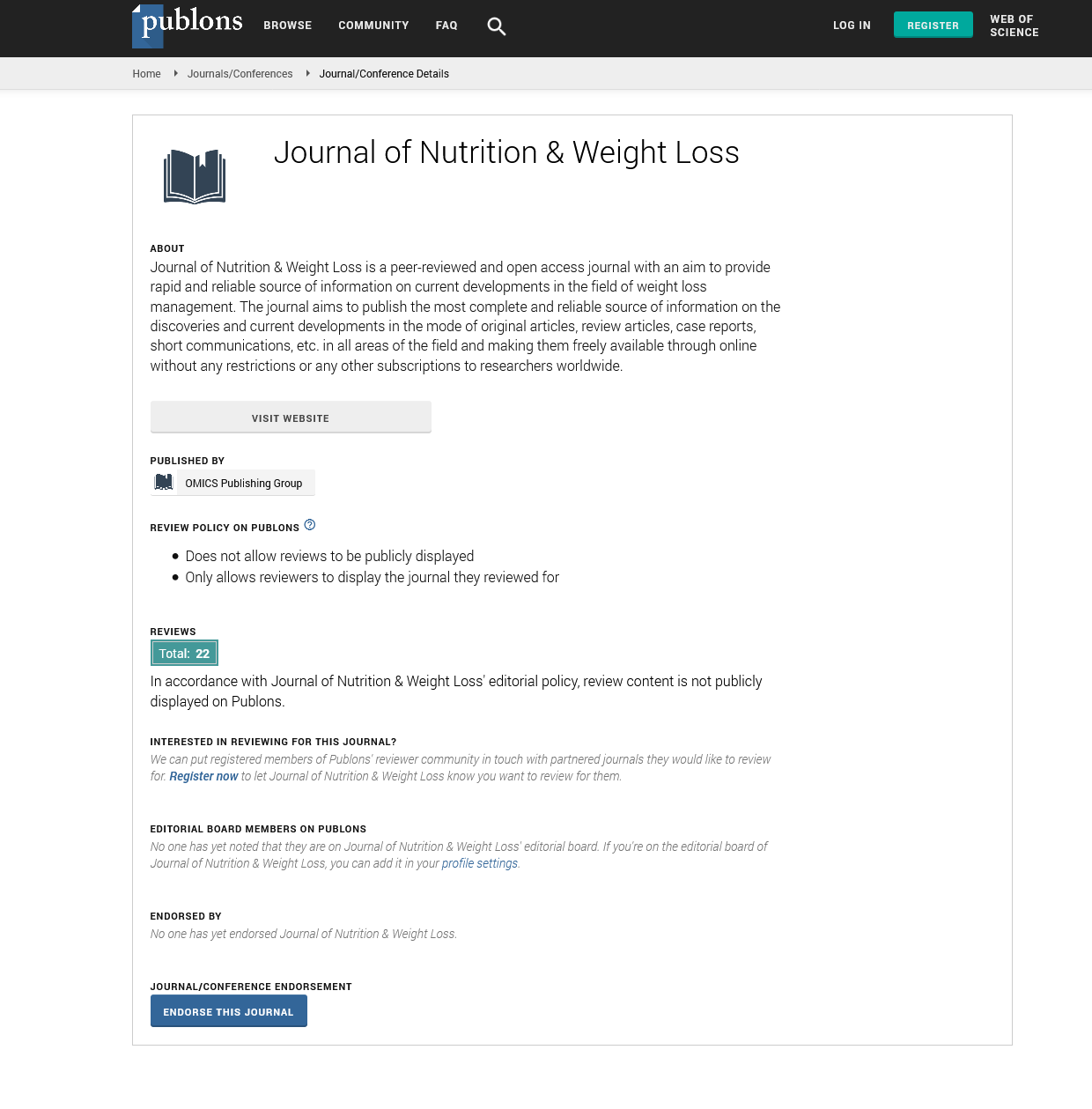Indexed In
- RefSeek
- Hamdard University
- EBSCO A-Z
- Publons
- Euro Pub
- Google Scholar
Useful Links
Share This Page
Journal Flyer

Open Access Journals
- Agri and Aquaculture
- Biochemistry
- Bioinformatics & Systems Biology
- Business & Management
- Chemistry
- Clinical Sciences
- Engineering
- Food & Nutrition
- General Science
- Genetics & Molecular Biology
- Immunology & Microbiology
- Medical Sciences
- Neuroscience & Psychology
- Nursing & Health Care
- Pharmaceutical Sciences
Perspective - (2023) Volume 8, Issue 4
Explaining the Role of Calorie Restriction and its Potential to Protect Against Neurological Damage in High-Fat Diets
Chinghai Benjam*Received: 27-Nov-2023, Manuscript No. JNWL-23-24800; Editor assigned: 30-Nov-2023, Pre QC No. JNWL-23-24800 (PQ); Reviewed: 14-Dec-2023, QC No. JNWL-23-24800; Revised: 21-Dec-2023, Manuscript No. JNWL-23-24800 (R); Published: 29-Dec-2023, DOI: 10.35248/2593-9793.23.8.194
Description
Obesity is a medical condition where body fat has accumulated to the point of having an adverse effect on health. It is usually defined by using the Body Mass Index (BMI), which compares a person's body weight to their height. Those with a BMI over 30 are considered obese. Obese individuals are at higher risk for chronic diseases like type 2 diabetes, high blood pressure, heart disease, stroke, and certain types of cancer. Calorie Restriction (CR) has been found to be an effective tool for combating obesity. CR involves reducing the amount of energy consumed while still getting enough nutrients for good health. It is important to note that while CR can help reduce body weight, it also has other benefits such as reducing inflammation and improving cardiovascular and metabolic health.
Exercise has long been associated with healthy body composition and reducing obesity-related health risks. However, recent research suggests that there may be additional benefits to regular physical activity in terms of neuroprotection in people who are overweight or obese due to high-fat diets. Studies have shown that consistent moderate exercise can reduce inflammation in the brain, improve cognitive functioning, and even reduce the risk of developing Alzheimer’s disease or other forms of dementia.
Calorie restriction is an essential component of any healthy lifestyle, as it involves reducing caloric intake without causing malnutrition. Studies have shown that restricting calories may improve brain health, as well as reduce inflammation and oxidative stress. Additionally, exercise can slow down the progression of age-related cognitive decline and protect against various neurological diseases, such as Alzheimer's disease. This is due to its ability to improve blood flow to the brain, increase levels of neurotropic factors that promote neuron growth, and boost antioxidant activity in the brain.
CR involves reducing calorie intake below what is typically recommended for an individual’s age and activity level. While this can be difficult to achieve, there are ways that individuals can make subtler cuts to their calorie intake without significant reducing their caloric intake overall. For instance, reducing portion size or switching to lower calorie snacks can help reduce overall caloric intake without feeling “deprived” or overly restricted. When it comes to achieving neuroprotection in highfat diet-induced obesity, CR has been suggested as a key component. Studies have shown that CR can reduce inflammation caused by obesity and improve glucose tolerance, both of which are necessary for maintaining healthy brain function over time. Furthermore, CR has been linked to increased neuronal integrity in the hippocampus, which is an important brain region for memory formation and long-term storage of memories. In other words, CR may help protect the brain from degenerative diseases by preserving hippocampal integrity over time.
The achieving neuroprotection in high-fat diet-induced obesity lies in careful caloric restriction and regular exercise. Calorie restriction, or reducing calorie intake without malnutrition, can help regulate metabolic functions and protect against the dangers of obesity. Regular physical activity is also beneficial, as it helps reduce inflammation and improve cognitive function. Together, these two strategies have been found to be a powerful tool in mitigating the neurological damage typically caused by indulging in a high-fat diet.
Physical activity has long been known to help promote overall health and fitness, but research has now shown that it can also be effective in reducing inflammation and improving cognitive functions. Studies have found that regular exercise reduces systemic inflammation markers, meaning that it helps to reduce the body’s overall inflammatory response to certain stimuli. In addition, evidence suggests that physical activity can improve executive function such as memory, attention span, decision making and problem solving abilities. This is likely due to an increase in neural connections within the brain which improves communication between neurons.
When combined with calorie restriction, these two strategies have been proven extremely effective in protecting against neurological damage caused by a high-fat diet. Research indicates that caloric restriction helps reduce levels of cholesterol and triglycerides while increasing levels of beneficial HDL cholesterol all factors which help protect against obesity-related diseases such as diabetes or cardiovascular disease. Furthermore, evidence suggests that calorie restriction helps preserve neuronal structure which reduces neuron degeneration associated with obesity and its associated diseases.
Neuroprotection in high-fat diet-induced obesity is an important step in maintaining overall good health. Calorie Restriction (CR) has been shown to be one of the most effective ways to reduce neuroinflammation and protect memory functions. Calorie restriction involves limiting food intake and reducing total energy intake. This helps to reduce inflammation in the brain, improve cellular resilience, and promote a healthy environment inside cells. Studies have shown that CR can reduce oxidative stress in neurons, protect against cognitive decline, and even improve mitochondrial function. While it is clear that CR can be beneficial on its own, when combined with exercise the effects are amplified. Exercise helps to increase blood flow to the brain, which improves brain functioning by allowing more oxygen and nutrients to reach the neurons.
Citation: Benjam C (2023) Explaining the Role of Calorie Restriction and its Potential to Protect Against Neurological Damage in High-Fat Diets. J Nutr Weight Loss. 8:194.
Copyright: © 2023 Benjam C. This is an open access article distributed under the terms of the Creative Commons Attribution License, which permits unrestricted use, distribution, and reproduction in any medium, provided the original author and source are credited.


